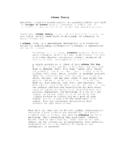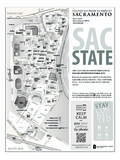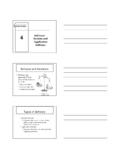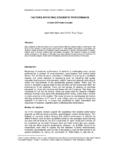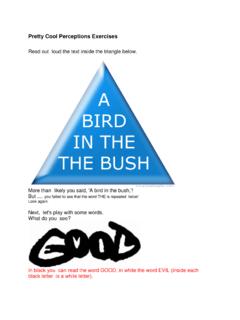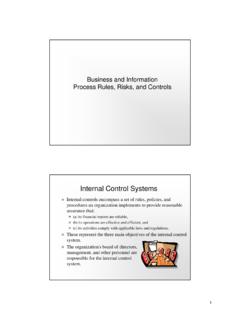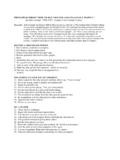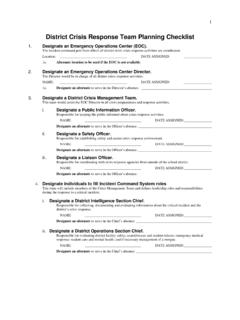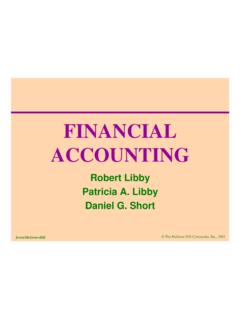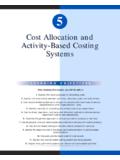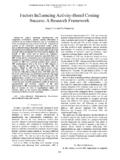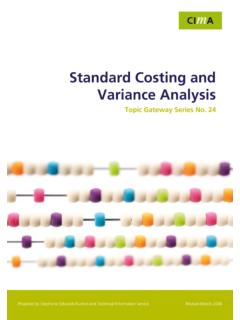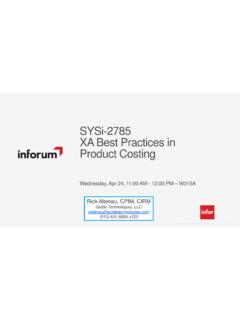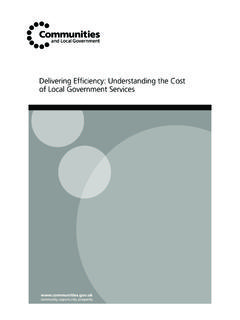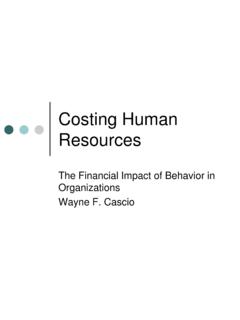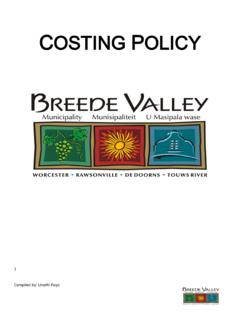Transcription of Chapter 9: Absorption/Variable Costing
1 Chapter 9: Chapter 9: Absorption/Variable CostingH 13 1 Horngren 13eABSORPTION Costing Absorption Costing is required for external financial reports and for tax reporting. Under absorption Costing , product costs include allmanufacturing costs: Direct materials. Direct labor. Variable manufacturing overhead. Fixed manufacturing overhead. Under absorption Costing , the following costs are treated as period expenses and are excluded from dproduct costs: Variable selling and administrative costs. Fixed selling and administrative COSTINGVARIABLE Costing Variable Costing is an alternative for internal management reports. Under variable Costing , product costs include only the variablemanufacturing costs: Direct l b ( lfi d) Directlabor(unlessfixed).
2 Variable manufacturing overhead. Under variable Costing , the following costs are treated as period expenses and are excluded from product costs:Fi df t ih d Fixed manufacturing overhead. Variable selling and administrative costs. Fixed selling and administrative Objective 1: Identify what distinguishes variable Costing .. fixed manufacturing costs excluded from inventoriable costs from absorption Costing .. pgfixed manufacturing costs included in inventoriable costs[EXERCISE]5[SOLUTION][]6 Learning Objective 2: Compute income under absorption Costing (using the gross-margin format) and variable Costing (using the contribution-margin format) and )g(gg)explain the difference in income.
3 Affected by the unit level of production and sales under absorption Costing , but only by the unit level of sales under variable costingg[EXERCISE]7[SOLUTION]8 Learning Objective 3: Understand how absorption Costing can provide undesirable incentives for managers to build up inventory .. producing more units for gpypginventory absorbs fixed manufacturing costs and increases operating income9 Learning Objective 3: Understand how absorption Costing can provide undesirable incentives for managers to build up inventory .. producing more units for gpypginventory absorbs fixed manufacturing costs and increases operating income One motivation for an undesirable buildup of inventories could be due to the fact that a manager s bonus is based on absorption- Costing operating income.
4 Top management can take several steps to reduce the undesirable effects of absorption on careful budgeting and inventory planning to reduce management s freedom to build up excess a carrying charge for inventory in the internal accounting systemoIncorporate a carrying charge for inventory in the internal accounting the period to evaluate performance. Instead of quarterly or annual horizon, evaluate the manager over a three-to-five year nonfinancial as well as financial variables in the measures of performance oInclude nonfinancial as well as financial variables in the measures of performance Objective 4: Differentiate throughput Costing (direct material costs inventoried) from variable Costing (variable manufacturing costs inventoried) and g(g)absorption Costing (variable and fixed manufacturing costs inventoried)Sales500 Sales500 Sales500 CGS120VC155DM50G Pfit380Ct M i345 Thh Mi450 AbsorptionVariableThroughputGross Profit380 Contr.
5 Margin345 Through Margin450S & A exp350FC315Op ex420 Profit30 Profit30 Profit30 In the very short run, many variable costs do behave as though they were fid fixed. For example, consider a restaurant. When a server comes on duty, that server will likely work until the end of the shift. Even though business may fluctuate and the server may not stay busy Even though business may fluctuate and the server may not stay busy the entire time, the employer is on the hook for 8 hours pay. The employer cannot (from a practical standpoint) tell the employee to take an hour off because business is slow. Th th f th d i l fid 11 Thus, the server s wages for the day are in a very realsense, Objective 5: Describe the various capacity concepts that can be used in absorption Costing .
6 Theoretical capacity, practical capacity, normal capacitygpy,ppy,pyutilization, and master-budget capacity utilization1. Determining the appropriate level of capacity is one of the most strategic and difficult decisions managers face. Too much capacity means incurring costs of unused capacity. Too little capacity means that demand may go different capacity levels are used to compute the budgeted fixed different capacity levels are used to compute the budgeted fixed manufacturing cost rate. They are: Theoretical capacityPtil it Practicalcapacity Normal capacity utilization Master-budget capacity capacity is the level of capacity based on producing at full efficiency all the time.
7 This measure of capacity does not allow for plant maintenance shutdowns interruptions or any other factors Theoretical maintenance, shutdowns, interruptions, or any other factors. Theoretical capacity may be achieved for short periods of time, but it cannot be sustained. Theoretical capacity represents an ideal goal of capacity Objective 5: Describe the various capacity concepts that can be used in absorption Costing .. theoretical capacity, practical capacity, normal capacitygpy,ppy,pyutilization, and master-budget capacity capacityis the level of capacity that reduces theoretical capacity bypypypyyconsidering unavoidable operating interruptions scheduled maintenance or holidays, for example.
8 5 Normal capacity is the level of capacity utilization that satisfies average capacity is the level of capacity utilization that satisfies average customer demand over a period of time often two to three capacity utilization is the level of capacity that managers expect for the current time period, frequently one Theoretical and practical capacity measure capacity in terms of what a plant can supply. Normal capacity and master-budget utilization measure capacity can supply. Normal capacity and masterbudget utilization measure capacity in terms of demand. 8. The capacity level chosen will affect the budgeted fixed overhead cost rate. As a lower capacity level is chosen the fixed cost per unit increasesAs a lower capacity level is chosen, the fixed cost per unit vs.
9 Absorption Costing ProblemThe Zwatch Company manufactures trendy, high-quality moderately priced watches. As Zwatch s senior financial analyst, you are asked to recommend a method of inventory Costing . The CFO will use your recommendation to construct Zwatch s 2004 income statement. The following data are for the year ended December 31, 2004:Beginning inventory, January 1, 2004 85,000 unitsEnding inventory, December 31, 2004 34,500 units2004 sales 345,400 unitsSelling price (to distributor) $ per unitVariable mnfc cost per unit, incl. DM $ per unitVariable operating cost per unit sold $ per unit soldFixed MOH$1,440,000 Denominator-level machine-hours 6,000 Standard production rate 50 units per machine-hourFixed operating costs $1,080,000 Assume standard costs per unit are the same for units in beginning inventory and units produced during the year.
10 Also, assume no price, spending, or efficiency Prepare income statements under variable and absorption Costing for the yearended December 31, What is Zwatch s operating income under each Costing method (in percentageterms)?3. Explain the difference in operating income between the two Which Costing method would you recommend to the CFO? Why?14 SolutionIncome Statement for the Zwatch Company, Variable CostingFor the Year Ended December 31, 2004 Revenues: $22 345,400 $7,598,800 Variable costs Beginning inventory: $ 85,000$ 433,500 Variable manufacturing costs: $ 294,900 1,503,990 Cost of goods available for sale1,937,490 Deduct ending inventory: $ 34,500 175,950 Variable cost of goods sold1,761,540$ Variable operating costs.
